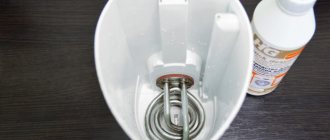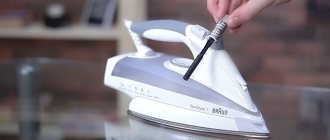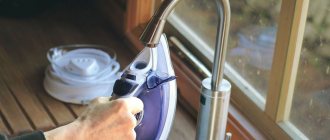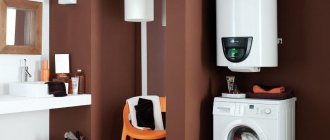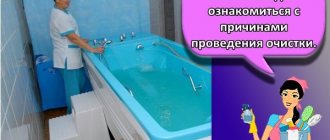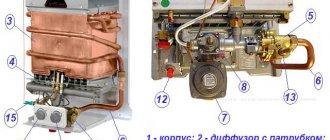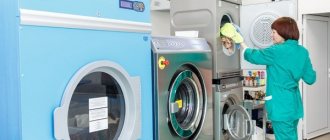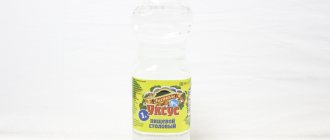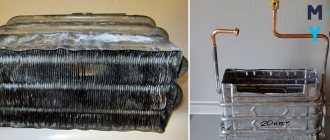How does a humidifier get dirty? How to clean limescale from a humidifier? How to clean mold from a humidifier? Important rules for cleaning a humidifier
A healthy atmosphere in the home largely depends on the quality of the air. To make breathing easy, house plants to grow well, and wooden furniture not to deteriorate from dryness, you need a humidifier. It will improve air quality, but will require reciprocal care. Let's figure out how often to wash a humidifier and why it is even necessary.
Why does plaque form?
The device is used to increase the moisture content in the air, which may decrease due to:
- operation of heating devices;
- incorrect design of the location of doors and windows in the house;
- the presence of the so-called sunny side in the room;
- high or low temperatures in winter and summer.
Important! The optimal level of humidity is 40-75%.
The device allows you to maintain good health. Low hydration may cause weakness, general discomfort and dizziness. An electrical appliance is also needed to clean the room from microscopic dirt and dust. A humidifier is necessary for people with chronic respiratory diseases.
The mechanism of operation of the device depends on its type:
- cold or hot humidifiers (use cold or hot steam, respectively);
- ultrasonic devices.
An air humidifier requires systematic maintenance, in particular cleaning. The device operates using water that is poured into the tank. It often causes the appearance of mineral deposits on the walls. This is why the use of tap water is considered undesirable.
The formation of scale is a natural process. Hard water contains calcium, magnesium and other biological substances. When water evaporates, scale forms on the parts of the device and its internal walls. Plaque shortens the life of the device and negatively affects air quality.
Important! Operating the device without regular cleaning releases harmful substances. To simplify the procedure for caring for the device, you should fill it with boiled or filtered water if possible. We recommend reading: How to remove brilliant green from linoleum
Why can they get dirty?
Typically, air humidifiers are constructed from an electronic unit and a container with an open or closed type evaporator. It is made of durable and hygienic plastic, chemically neutral to various substances. The main reason for the appearance of contaminants inside the device is the aquatic environment, which is a favorable basis for the proliferation of various microorganisms
Most often, owners of air humidifiers do not pay enough attention to the quality of the liquid poured into the reservoir. But tap water is characterized by increased hardness, contains mineral salts and other components, which, when the volume of the medium evaporates, change the concentration
As a result, dangerous chemical compounds settle inside the device, cover its parts, and disrupt electrical conductivity. The white coating or scale that forms on the heating element and the walls of the vessel appears in this way.
Why is such a neighborhood dangerous? Primarily the development of pulmonary diseases. Mold spores emitted by the device into the air are a strong allergen and are especially dangerous for children and the elderly, whose immune defenses are less perfect. It is worth considering that water blooming is a direct consequence of poor maintenance of the device. If you regularly clean the inside of the tank, it will bring exceptional health benefits.
A humidifier in your home can become dirty not only inside, but also outside. If fingerprints are left on the housing or a greasy coating forms, this can also pose a danger to the device itself and to the health of others. External cleaning must be carried out simultaneously with removing plaque from inside the container. In addition, it will be useful to remove dust from the surface of the device during routine cleaning.
Types of Humidifiers
Manufacturers offer several types of devices to improve the microclimate. The following options can be purchased:
- cold humidification device (produces cold steam);
- hot humidification device (with hot steam);
- ultrasonic humidifiers (an ultrasonic element turns water into dust).
In order for the device to function fully, it needs periodic cleaning.
How the device works
During operation, the air humidifier accumulates scale and therefore requires cleaning.
The principle of operation of the humidifier is based on the effect of evaporation of water heated by boiling or by ultrasonic influence on it. To activate the process, you will need to pour liquid into the tank, then plug the device into a power outlet and press the “Power” button.
In addition to its main function, a household humidifier is capable of solving other problems:
- clean the air from foreign impurities and dust;
- eliminate electrostatics;
- used as a source of medicinal aromas.
In the latter case, a special capsule with aromatic oils is installed in it. This allows you to maintain the required level of humidity in the apartment and at the same time inhale healing vapors.
Cleaning procedure
Scale is a dense mineral deposit that forms on the side surfaces of the tank. To clean a household humidifier from deposits, you need to do the following:
- Turn off the device. Remove the tank from the base and disassemble it into elements.
- Free it from water and rinse.
- Treat the inner surface with a cleaning compound. Use a soft sponge to remove softened scale.
- Wipe the outer part of the body with a flannel soaked in diluted table vinegar (3%).
In ultrasonic humidifiers, you need to clean the membrane surface with a special brush. It is included in the package.
How often should I clean?
Cleaning your humidifier is an essential part of a comprehensive procedure for maintaining its performance. In this case, the reason for contamination of the device lies in the principle of its operation and depends on the version of the selected model.
For example, the operation of steam humidifiers is often compared to the operation of an electric kettle - during the boiling process, water turns into steam and, combining with air, significantly increases its humidity. However, when boiling, all salts and other mineral compounds do not evaporate, but are deposited on the heater, forming a hard limescale deposit.
It is important to understand that plaque is not only an aesthetic nuisance, because it negatively affects the performance of the device, significantly reducing its heating function and contributing to early breakdown.
The operating principle of ultrasonic devices looks somewhat different. A special membrane, through the ultrasonic vibrations it creates, breaks moisture into fine particles, which are subsequently mixed with the surrounding air. In this case, the salts contained in the water settle both on the internal parts of the unit and on the surfaces surrounding it (furniture and walls).
The traditional version of the humidifier works by creating an air flow based on contact with a wet cartridge, forming a process of evaporation of moisture. In this case, all mineral salts remain in the cartridge, clogging it and thereby disabling the device.
If used regularly, the humidifier must be cleaned at least once a week, thoroughly wiping and removing salt deposits.
Positive and negative properties of aromatic oils
Even in ancient times, various ailments were treated with plant extracts. Nowadays, modern science has proven that these substances really have a beneficial effect on mental and physical health. The phytoncides contained in the essential product enter the bloodstream when inhaled, so they have an immediate effect.
Essences are especially useful if you need to restore the nervous system and put your mental and emotional state in order. Aroma oils added to a humidifier have a beneficial effect on:
- functioning of the respiratory and cardiac systems;
- appearance of hair and skin;
- brain function and ability to concentrate;
- the immune system, making the body more resistant to viral and bacterial infections.
For the most part, essential oil contains antioxidants that prevent premature aging and remove harmful carcinogens from the body. Therefore, plant extracts are often used as substances that optimize the functioning of the body and effectively fight many diseases.
However, do not forget about the negative properties of aromatic oils. An air humidifier that emits a rich herbal odor along with steam, in addition to a positive effect, in some cases also has a negative effect. Thus, the addition of natural flavoring can be harmful if the dosage is not observed and the extracts are mixed incorrectly.
What harm can aromatherapy cause?
Inhaling healing vapors can have a negative effect if:
tendency to allergies (you need to be especially careful when handling sage and thuja); bronchial asthma (an attack can be sudden, so you should consult a doctor before performing the procedure); pregnancy (special care should be taken when using rosemary, cedar, sage and basil); breastfeeding (the inhaled aroma with mother's milk will instantly enter the baby's blood, which can have a negative effect on a fragile body). Also, people who have problems with the thyroid gland, kidneys or high body temperature should avoid the procedure during which a humidifier with aromatherapy function is used
Also, people who have problems with the thyroid gland, kidneys or high body temperature should avoid the procedure during which a humidifier with aromatherapy function is used.
Methods for cleaning scale in a humidifier
In order to understand how to descale an air humidifier, you should figure out which model of air humidifier is in the house, and then study the operating instructions.
Depending on the method of humidification, devices are:
- Ultrasonic.
- Traditional or mechanical - with cold evaporation.
- Ionic (electrostatic).
- Steam.
Ultrasonic
Inside the ultrasonic device there is a membrane that is driven by sound waves. The liquid falling on it is converted into small steam particles, which are dispersed throughout the room by the built-in fan.
To remove scale from this appliance you must:
- empty the reservoir of any remaining liquid;
- rinse it thoroughly under running water;
- carefully clean all parts of the device from plaque, use a soft sponge or brush for this; it is not advisable to use an abrasive agent, as it can damage the surfaces;
- the remaining scale is removed using a vinegar solution (1 tablespoon per 0.5 liter of water), which is filled into the container and left for several hours; vinegar can be replaced with citric acid;
- then wash well and wipe dry with a towel.
Mechanical
The operating principle of mechanical humidifiers is the natural evaporation of liquid without heating. Contamination of such a device can be cleaned without the use of special products. Regular care and fluid replacement will improve its performance.
Ionic
Ionic models perform the following functions:
- increase indoor humidity;
- clean the space from dust, wool, unpleasant odors;
- improve and aromatize the air.
In addition to cleaning the water tank, they require filter replacement.
Steam
Steam humidifiers are most susceptible to scale formation. The evaporation of steam in these models occurs due to the boiling of water. You can remove plaque in the same way as cleaning an electric kettle.
Reasons for contamination of a household humidifier
Of course, using a humidifier has a number of pros and cons. One of the latter is the need to regularly maintain it. But, before we start cleaning the devices, let’s find out where and for what reasons the pollution appears outside and inside.
Dirt on the outside of the housing and on the outer walls of the water tank appears from dust. The less often you clean, the faster the humidifier will get dirty.
Regular cleaning of the premises is the key to cleanliness and a healthy microclimate. Along with clean air, you get well-maintained household appliances, furniture and home textiles
If the plastic parts are still dirty on the outside, you just need to wipe them with a cloth soaked in soapy water. Do not use abrasives, which will instantly ruin the appearance of the device, destroy the gloss and leave small scratches.
Almost all parts of the humidifier, except the control panel, power supply and fan, are in contact with water. To take a closer look at the device and types of humidifiers, please follow the link.
It is more difficult to deal with contaminants on the internal walls, small plastic parts or in the tank. And they will appear in any case, because tap water, even filtered, contains a large number of various impurities.
Rust and lime, known to all housewives, remain the causes of stains, deposits and plaque.
In addition to them, the water contains:
- manganese;
- magnesium;
- sulfides;
- fluorides;
- chlorides;
- various organic compounds.
These and other compounds are constantly deposited on the plastic. And if you do not clean the humidifier in time, then microorganisms harmful to health will appear on the internal surfaces, or even mold will grow.
Together with water droplets, microbes, bacteria and mold particles will spread throughout the room, which can adversely affect the health of residents
You need to start fighting harmful microflora from the very first days of the appearance of a humidifier in the house, carrying out preventive measures. If you miss the moment, the evaporator, water tank, and all internal surfaces will become covered with an unpleasant rusty, yellowish or whitish coating.
But don't be alarmed - there are several proven means of getting rid of this dirt.
How to descale a humidifier
To remove scale from the humidifier, you need to remove the water container and also disconnect other removable parts. Before adding the cleaning agent, you must pour out the remaining liquid from the tank. The tank is thoroughly washed under the tap, and the body is wiped using a soft cloth. It is moistened in a concentrated solution of vinegar essence. This procedure prevents dust from settling on the surface.
How to descale a humidifier with citric acid
To remove mineral deposits, it is not necessary to purchase household chemicals. You can descale your humidifier using citric acid. The natural substance eliminates dirt and unpleasant odors.
Cleaning a humidifier from scale with citric acid is a simple procedure. The reservoir is filled with water and 60 g of powder is added. The device must be turned on for 1 hour. Then the dirt must be cleaned with a sponge.
Citric acid softens plaque, which causes it to peel off from the walls of the device
Vinegar
The essence allows you to remove scale from the humidifier by softening it. The composition includes concentrated vinegar (100 ml) and boiled (filtered) water corresponding to the maximum volume of the tank. The prepared solution is poured into the cleaning tank and the device is turned on. The operating time of the device is 30 minutes.
Vinegar essence helps clean scale and other contaminants
Soda
Sodium bicarbonate fumes are not dangerous, which makes it possible to clean indoor air conditioning equipment. Pour water into the reservoir, add baking soda (60 g) and stir thoroughly. The device should be turned on for 1 hour. Then the tank is thoroughly washed.
We recommend reading: Baking soda: beneficial properties, uses, how to take
Baking soda removes mineral deposits and disinfects appliance surfaces
By special means
The water tank should be washed using a soft cloth. Brushes with hard bristles should not be used. These products can compromise the integrity of internal parts and lead to intense accumulation of dirt. You can clean the device with a solution of laundry soap. After the procedure, wipe the device dry.
You can remove fresh scale from your humidifier without using special cleaning compounds. For this purpose, it is recommended to use a toothbrush that has soft bristles.
Attention! It is prohibited to rub the surface of the device intensively during cleaning. Otherwise, scratches may occur.
You can get rid of hard scale in your humidifier using special cleaning products. The composition is applied to the surface following the manufacturer's recommendations.
Antiscale effectively removes limescale deposits in electrical appliances
Review of safe and effective products
We will look at popular solutions that can always be found at home or bought in the supermarket. All of them are safe if you follow the dosage or instructions. But when working with aggressive chemicals or simply unknown substances, do not forget to use gloves, and if there is a strong smell, do not be lazy to wear a mask.
Remedy #1 - citric acid
Citric acid is found in many household cleaning products, but is also effective as a regular solution.
Food grade citric acid packets are sold in grocery stores. Their low cost is incomparable with the enormous benefits that a regular lemon solution brings.
The food product, unlike the chemical reagent, is not dangerous, so special protective equipment does not need to be used.
Citric acid is used in different ways:
- wipe the contaminated areas with a cloth;
- apply to a brush and clean hard-to-reach places;
- pour the solution and leave for a while.
If you want to know how to properly clean a humidifier from mineral scale, remember the recipe for preparing the “magic remedy”. It is simple: dissolve 2-3 tbsp in 1 liter of water. spoons of acid powder. You can try a more concentrated solution - it won’t make it worse.
Filling inside containers is most effective.
The solution is used to fill both the water tank, if plaque has appeared in it, and the inside of the housing - for example, the steam-generating chamber of an ultrasonic device
The solution is left for 30-40 minutes, drained, and the softened salts are removed with a cloth or brush. Then rinse and wipe dry.
Citric acid is safe and effective against various deposits, therefore it is included in cleaning products officially approved by manufacturers of climate control equipment.
Remedy #2 – Baking Soda
Baking soda, which housewives often use for baking or cleaning kitchen utensils, is also suitable for cleaning a humidifier. It is as safe as citric acid, but, unlike it, it is an alkaline product.
Sodium bicarbonate or baking soda is a substance that is always available for free. Among other things, it has a disinfectant effect, which can also be useful when cleaning household appliances
It is not recommended to rub plastic parts with dry powder. As a result of such an aggressive approach, the surface will lose its smoothness, and deposits will “grow” even more. It is necessary to make a saturated solution - approximately 1 tbsp. spoon in a glass of water - and rub the contaminated areas with it.
After cleaning, all parts must be rinsed with clean water, either directly under the tap or in the shower. It is better to wipe the external surfaces dry so that there are no streaks left.
If you notice the first signs of mold, cover the affected areas tightly with baking soda and leave for a while. Alkali prevents the growth of fungus and also acts as an active antiseptic.
Remedy #3 – weak vinegar solution
Acetic acid acts on the principle of citric acid - it softens deposits and makes them more pliable during cleaning. But it is not recommended to use a concentrated solution; even table vinegar is recommended to be diluted with water.
The fact is that any acid can affect polymers in its own way. It is possible that microcracks will appear, which will contribute to rapid contamination. Therefore, before you start using vinegar, carefully read the manufacturer’s instructions - they usually list substances and solutions that cannot be used to clean or disinfect devices.
Table vinegar, like baking soda or citric acid, is available at the grocery store. Although it is a liquid and not a powder, it requires additional dilution with water
Usually table vinegar is combined with water in a 1:1 ratio, but if you use acid or essence, the percentage of water will be much higher.
After wiping with the solution, all parts must be thoroughly rinsed. Unlike soda, vinegar has a strong, persistent odor, and if you make too concentrated a solution, this “aroma” will remain in your apartment for a long time.
Remedy #4 – special detergents
Grandmother's products are good, but today you can find many more effective and equally safe special detergents on the market.
Let's consider one of them - a universal bathroom product from the popular Faberlic brand, which contains a whole complex of various acids.
The detergent is sold in 0.5 liter containers and is suitable for cleaning any surfaces: tiles, ceramics, plastic, acrylic, sanitary ware, enameled and chrome-plated products
The solution copes equally well with both red rust and difficult-to-remove lime deposits.
To avoid unpleasant consequences, it is recommended to first treat a small area of plastic and look at the result. If the structure of the material remains the same, but the dirt begins to lag behind, it can be used.
Procedure:
- Apply the composition to contaminated areas.
- Leave for 2-3 minutes.
- Treat with a sponge or brush.
- Rinse with water.
If the plaque is strong, you can increase the exposure time to 5 minutes, but no more. The procedure can be repeated several times until the deposits are completely destroyed.
If you decide to choose some household chemicals yourself, be sure to read the manufacturer’s recommendations. It’s better if the product can be used to clean dishes – then it’s really safe.
Universal care instructions
The humidifier constantly needs preventative cleaning, even if it is new and has not yet become “overgrown” with a thick layer of plaque. This usually involves washing all parts with either clean water or a special solution. But no matter what kind of humidifier you have, the same instructions for regular maintenance can be applied to it.
Step-by-step instructions:
If the manufacturer has not left precise instructions for cleaning the filter, then rinse it with clean water to avoid damage.
If you decide to more seriously clean the filter of your home humidifier, proceed in the following order:
- Turn off the device.
- Carefully disconnect and remove the filter.
- Rinse under running water.
- If any dirt remains, soak in a solution of citric acid.
- Gently go over all critical areas with a soft brush.
- Wash away any remaining plaque with water.
- Dry and place on the workbench.
It is better to study the characteristics of the filter in advance by looking at the instructions. Some models have replaceable cartridges - they need to be changed on time. But there are also replaceable parts that you can clean several times yourself, and then buy new ones.
Features of pollution
To clean the walls of the humidifier, you can use vinegar and plain water.
The main reason for the formation of plaque on the walls and structural elements of the device is pouring too hard water into it, the content of mineral salts in which exceeds the norm. The deposits that have accumulated over time can no longer be removed with a dry cloth. You will need effective cleaning products typically used at home:
- baking soda;
- vinegar solution;
- lemon acid;
- standard bleach.
The device can become dirty for several reasons. Tap water is very hard; it contains calcium and magnesium salts, which provoke the formation of limescale inside the humidifier, and during its operation spread through the air in the apartment. Getting rid of this plaque is very difficult. Also, this water may contain harmful microorganisms, which not only contribute to the formation of mold, but also enter the respiratory tract of the home owners during operation of the device.
Cleaning your humidifier is easy
During operation, scale forms which can damage the device.
Depending on the type of air humidification device, the following types of clogging are distinguished:
- Steam humidifier. When the temperature of the liquid reaches its maximum and turns into a vapor state, salt compounds and minerals turn into a film of lime with a dense structure. The danger of a mud layer lies in the disruption of the functioning of the device, which over time will stop heating the steam.
- Mechanical device. Water flowing through the filter leaves salt particles on the walls, which leads to a deterioration in the filtering capabilities of the device. A humid environment contributes to an increase in the number of pathogenic microorganisms that cause a putrid odor.
- Ultrasonic device. The liquid breaks down into dust particles of high humidity, which are concentrated on the humidifier.
How to deal with white residue from a humidifier
If a white coating appears on furniture surfaces, this does not mean that you need to buy another humidifier. Precipitation does not mean a breakdown, but indicates improper use of the device. Therefore, it is necessary to find the reason for the appearance and analyze your actions. In most cases, the problem lies in stagnant or hard water, so it will need to be replaced. If plaque continues to form on surfaces, it is worth using other methods.
Changing water
Adding running water to the fluid compartment is a common mistake. High-quality water does not always flow from the tap; most often it is hard or has sediments that can be clearly seen at the bottom of the glass. Therefore, first of all, it is necessary to boil water, and only then pour it into the tank. If this does not help, it is better to use distilled liquid, which is sold in all household stores.
Filter installation
Special built-in filters can eliminate plaque formation or delay its appearance. The following types of built-in filters stand out on the modern market: carbon, fiberglass or ion exchange resin. The principle of operation is the same, the only difference is the cost. A carbon filter is inexpensive, but the cost of others can reach 5 thousand rubles.
Buying an ultrasonic humidifier
An ultrasonic humidifier is a device that filters evaporating liquid. The difference from a conventional humidifier is the presence of a filter that filters out sediment and bacteria. You can add running water to such a device without pre-treating it. A humidifier will do this. Such a system is much more convenient, which is reflected in the cost of ultrasonic humidifiers. But even in such cases, you should not relax and forget about the correct operation of the device. Filters need to be changed every 3 months, otherwise the appearance of white deposits cannot be avoided again.
Reverse osmosis installation
This option is the most expensive, but also the most effective. This method will not only prevent the appearance of plaque, but will filter the entire flow of water entering a particular room. A reverse osmosis system is installed in the water supply, as a result of which the liquid is purified from salts and impurities and supplied to users in its pure form.
Getting rid of plaque
The layer of hardened salts cannot be removed mechanically. You will need soda, citric acid or vinegar, which reacts with harmful impurities and softens the plaque. The component is diluted with water until completely dissolved and the resulting mixture is poured into the tank. Per liter of liquid you will need 2 tablespoons of soda, or 100 g of citric acid or 150 ml of vinegar. Use only one of the ingredients listed. You cannot combine soda with vinegar, because the substances neutralize each other, and the plaque remains on the walls of the humidifier.
Place the device on the balcony or turn its nose towards an open window so that the sprayed liquid goes outside. Connect to the power supply and turn on for 30–60 minutes, pour the solution into the tank. Water with soda or citric acid will corrode the scale as it is sprayed, so at the end of the procedure the scale will fall off the walls of the device on its own. It is necessary to carefully clean off the loose pieces, and then rinse the tank under the tap. Rinse with clean water until the specific odor disappears.
Important: Ultrasonic and mechanical varieties are not turned on, but simply pour the solution into the reservoir and forget about the device for 12 hours. Pour the liquid with scale particles into the sink, rinse the tank and nozzle, and you can use the humidifier as usual
How to disinfect a humidifier?
Disinfecting the humidifier helps destroy pathogenic bacteria. The procedure must be carried out once every 14 days. For disinfection, you do not need to purchase additional compounds; the simple and accessible components available in the house will be sufficient.
White
For 1.1 liters of cool water, take 6 ml of chlorine bleach. Fill the reservoir with the solution and wait 60 minutes. There is enough time for complete disinfection. If you leave the solution longer, it can cause cracking of the tank walls.
Advice! To remove the bleach aroma, fill the humidifier reservoir with clean water and activate it. When steam formation begins, turn off the power to the device and pour out the water. Repeat steps until the bleach smell is completely eliminated.
Hydrogen peroxide
Pour 500 ml of the drug into the reservoir, wait 60 minutes. Then drain the peroxide and rinse the tank with clean water. There is no need to worry that particles of peroxide will remain on its internal surfaces. During evaporation, the remaining composition will disintegrate into oxygen molecules and water.
Table vinegar
Vinegar not only dissolves scale, removes fungi and mucus, but also helps disinfect the device. Dissolve 260 ml of product in 4.5 liters of water. Fill the tank and turn on the device for 1 hour. Cleaning should be done outdoors. After disinfection is completed, discard the liquid. Fill the humidifier tank with clean water. Let it run until steam forms. After this, drain the liquid again.
Why is scale dangerous?
Many humidifier users often don't even pay attention to the inside of the humidifier until it breaks. However, descaling of any type of humidifier should be done regularly to prevent a number of possible problems:
- The appearance and spread of pathogenic microorganisms.
- Flowering water.
- The appearance of mold.
- Formation of various types of chemical compounds that negatively affect human health.
- Deterioration of the device.
- Reducing the service life of the humidifier.
We recommend that you read: Choosing an air humidifier for children, rating the best models
Thus, it is necessary to remove scale and deposits from humidifiers with some regularity. However, at the same time, we should not forget about the use of proactive measures that would not allow such problems to arise. Thus, in particular, it is necessary to use preventive and disinfection measures. If scale has already appeared, then you should know how to clean the humidifier without harming it.
Features of cleaning an ultrasonic humidifier
The device is cleaned using the same methods, using soda, vinegar, and citric acid. Hydrogen peroxide is used for disinfection. The ultrasonic device is not turned on, the prepared liquid is poured into the tank and left for half a day, it gradually softens. Residues are removed with running water.
To clean an ultrasonic humidifier, turn it on, remove the reservoir and remove any remaining water, then rinse thoroughly. To treat the base, use vinegar or a solution based on a substance; it is applied with a sponge. To clean the membrane, use the brush included in the kit.
Disinfecting your humidifier also involves descaling. To remove plaque, you need to pour the prepared product into the tank and leave for 6 hours. During this time, the dirt will become wet; you will need to remove it with a soft cloth, then dry it and assemble the device. Do not use household chemicals (dishwashing liquid, floor liquid, plumbing solution, etc.).
Disinfection
Clogging of the internal elements of the device creates a favorable environment for the development of microorganisms, bacteria and mold. This situation poses a significant threat, since the entire “content” of the device is sprayed into the room, after which microorganisms enter our body through breathing. This can lead to the development of dangerous diseases
Therefore, it is important to carry out thorough disinfection
To remove microorganisms, bacteria and mold, the device must be disinfected. An aqueous solution of chlorine is used for this. Any bleach can be used effectively as a chlorine-containing product. A chlorine solution (water and one teaspoon of bleach) is poured into the device. The solution is left for 60 minutes. After exposure to a chlorine solution, all parts of the device should be rinsed several times with clean water until the characteristic smell of chlorine disappears.
Hydrogen peroxide is an effective alternative to chlorine
An alternative to chlorine solution is hydrogen peroxide. To prepare a solution, add ½ cup of hydrogen peroxide to 4 liters of water. The prepared solution is poured into the tank and the humidifier is turned on. After 2-3 minutes of operation, the device turns off and the solution is drained from it.
The humidifier is thoroughly rinsed with clean water. Water is poured into the container and the humidifier is turned on for a few minutes. Afterwards, you need to wash the device again. The procedure is carried out in a room with open windows or with the air conditioner turned on. It is recommended to carry out disinfection at least once a month.
How to remove fungus from a humidifier and clean mold from parts. A big problem can be removing mold that has formed on the walls of the water container if this part of the device is not removed from the device. How to clean an ultrasonic humidifier in this case? Regular solutions of chlorine and hydrogen peroxide are suitable for this. In 12-24 hours of settling in the container, they will remove all mold. If possible, you need to brush the inner walls.
What will help against mold, slime and greens?
Disinfection can rid the device of mold, greenery and mucus; there are three main ways to do it:
- Using bleach or bleach. Dilute a teaspoon of the reagent with 4.5 liters of water and pour it into the tank. The solution should be left in the container for an hour, after which the liquid should be drained and the container should be washed thoroughly under running water.
- Using vinegar. For the same volume of water, take a glass of vinegar and leave it in a working device for one hour (for ultrasonic humidifiers - in a non-working one). It is recommended to carry out the procedure outdoors, otherwise the room should be well ventilated.
- Peroxide. Pour several glasses of solution into the tank and leave for one hour. In this case, the peroxide should cover both the bottom and the walls.
Regular cleaning of the humidifier with baking soda and lemon can prevent the appearance of mold.
Mold removal
To remove mold deposits from the unit, you can use several simple and quite effective methods:
- bleach or bleach solution based on a dessert spoon of chlorine diluted in five liters of water. After an hour's exposure, the tank is thoroughly and repeatedly washed with copious amounts of water;
- a glass of table vinegar diluted in half a bucket of water is poured into the operating device for about an hour, after which the unit’s reservoir is thoroughly washed.
It is optimal to use pharmaceutical hydrogen peroxide, a sufficient amount of which is poured into the humidifier container for an hour.
Rules of care and prevention of contamination
To keep the device in excellent condition, you must follow simple rules:
- Take proper care of the device and disinfect it once every 10-12 days. The procedure will prevent the proliferation of microorganisms that enter the air.
- The appliance should be descaled once every 7 days. This will extend its service life and prevent breakdowns. If you do not regularly descale the device, its performance will decrease and its service life will be shortened.
- It is better to carry out cleaning and disinfection in the fresh air, in which case harmful substances will evaporate faster.
- If folk remedies for cleaning and disinfection do not give good results, you should purchase strong chemicals.
- To prevent scale from appearing too often, you need to use filtered or boiled water. It is recommended to empty it after use. If the water stagnates, a favorable environment for mold fungi is created.
- To extend the service life of the device, you should change the operating mode. It is important to remember that the equipment must rest. It is forbidden to pour in too little or too much water; you must follow the manufacturer’s recommendations.
- If any parts wear out, they must be changed in time, otherwise the device will not be able to function.
- It is important to monitor the condition of the filter and membrane.
- It is not recommended to use a device with defects; it is better to replace it with a new one.
Before cleaning the humidifier, you need to disassemble it. Then choose the most convenient method and purchase the necessary funds.
What solutions should not be used?
Wanting to achieve perfect cleanliness, users rub their devices with various compounds that are harmful not only to the plastic, but also to the health of the owners of the equipment themselves. To prevent them from accidentally being poisoned by harmful fumes, especially responsible manufacturers include in the instructions a long list of substances that are strictly prohibited to use. The list of permitted means, by the way, is much shorter.
The following are usually listed as prohibited:
- chlorine and any chlorine-containing solutions;
- aggressive concentrated acids;
- alcohol and alcohol-containing solutions;
- hydrogen peroxide;
- compositions with essential oils;
- petrol;
- kerosene;
- acetone and other solvents;
- toilet cleaners, etc.
Even light acidic products approved for use should not be left for long, as they can damage the structure of the material and significantly reduce the service life of the device.
Rules for choosing a humidifier
The humidifier is selected according to the availability of functions, power, operating principle
Dry air and high temperatures in the apartment have a negative impact on the health of adults and children. This is especially critical in the autumn-winter period, when atmospheric indicators are significantly higher than normal. A high-quality air humidifier will help solve this problem; when choosing it, the following points are taken into account:
- type of device purchased (mechanical or ultrasonic);
- performance;
- the presence of additional options (the ability to control humidity using a built-in sensor, for example, or remote control);
- reputation of the model manufacturer.
Taking these factors into account will help you choose the best humidifier, which, according to most users, includes some ultrasonic class models. This unofficial rating highlights products from the following companies:
- SENDO M200;
- KOENIG AIR 380;
- XIAOMI CJJSQ01ZM;
- PANASONIC F-VXR50R.
Relatively inexpensive, high-quality humidifiers include devices produced by the manufacturers Galaxy (model GL-8003) and Polaris (PUH 6504).
Benefits of essential oil
Plant extracts are an excellent way to cure certain types of diseases and restore mental health. Essential oils immediately begin their action as soon as a person inhales. Phytoncides enter the bloodstream and begin their beneficial effects. Oil flavorings have an excellent effect on the nervous system, improve mood, and restore the psyche.
Positive properties of oils:
- stimulate the functioning of the heart, brain, and respiratory organs;
- calm the nervous system;
- promote concentration and improve memory;
- make the immune system stronger, more resistant to viruses and bacteria;
- improve the quality of hair, nails, epidermis;
- have an antioxidant effect;
- remove carcinogens, prevent aging.
Continuous care
It is worth understanding that air humidifiers, like any other household devices, require regular maintenance. It is easier to prevent problems from occurring than to deal with their consequences. That's why you need to not only know how to clean your humidifier, but also how to take proper care of it.
Each type of air humidifier is characterized by its own specific features, and therefore requires specific approaches to cleansing:
- The basis for caring for mechanical devices for air humidification is periodic replacement of cartridges and regular cleaning of the container intended for filling water.
- Cleaning steam humidifiers is similar to how you clean electric kettles.
- When cleaning ultrasonic devices, the main thing is to properly care for the membrane to prevent damage. For this purpose, in most cases, the device comes with a special brush. If this is not available, then you can use a soft sponge or a piece of fabric - fleece is best.
Another important point in caring for devices designed for air humidification is the need to thoroughly wipe all components after washing. If you allow water to get inside, the device may simply burn out.
Why does scale appear?
Since the operation of any device designed to humidify indoor air is based on the use of water, the main reason for the appearance of plaque is the use of water of inadequate quality.
The instructions for devices always indicate the need to use distilled or, at a minimum, filtered water. In domestic conditions, situations often arise when this rule is not followed and ordinary available water is poured into the humidifier - from a tap, well, etc. However, the problem is that untreated water contains various salts - not to mention other microelements and even possible microorganisms.
Due to the use of untreated water, all the impurities present in it settle on the walls of the device, forming a predominantly white crust. If you do not regularly take action and do not clean the humidifier of plaque, the crust “petrifies” and contributes to the further accumulation of problems.
It should be said that the use of traditional mechanical appliances is fraught with the danger of not only the appearance of scale, but also the release of various types of bacteria into the room. Devices of this type are characterized by the phenomenon of water stagnation in the tank, as a result of which bacteria and other harmful organisms can multiply, and a rotten smell appears that spreads throughout the room.
Steps
Method 1
Perform basic cleaning
- 1
Rinse the filter.
First turn off the humidifier, then remove the filter. Rinse the filter under the tap with cold water to remove any dirt. Leave it to dry on a clean towel while you clean the other parts of the humidifier.
- Do not use cleaning agents to clean the filter. Chemicals can damage the filter so that it will not work properly.
Your humidifier model may need to change the filter from time to time. In this case, consult the user manual and change the filter as often as indicated.
- 2
Rinse the water tank.
Remove the tank from the humidifier and empty it of water. Pour 3 cups of vinegar into the tank, stir the vinegar until it completely covers the bottom and walls of the tank. Let it sit like this for an hour. Vinegar acts as a natural cleaner that loosens the buildup of bacteria in the bottom of the tank. Then rinse the tank thoroughly with water.
- If necessary, use a brush to remove dirt from the bottom of the tank.
Using another cleaner may have negative consequences due to the fact that the liquid in the tank may evaporate. Use vinegar to ensure you create a safe environment for your family.
- 3
Wipe the humidifier frame.
Take a sponge soaked in vinegar and water and wipe off the remaining parts of the humidifier. This will keep dust and other debris from getting into the water tank and prevent the growth of mold and bacteria.
Method 2
Disinfecting the humidifier
- 1
Using bleach and water.
Pour four liters of water into the humidifier tank and add a teaspoon of bleach. Leave the tank with the solution for an hour to completely disinfect it. Pour out the solution and rinse the tank with clean, cold water.
- Before putting the tank back into the humidifier, make sure to rinse it thoroughly.
Do not leave bleach in the humidifier for more than an hour, or it may damage it.
- 2
Use peroxide.
Pour a few cups of peroxide into the water tank. Stir the peroxide until it completely covers the bottom and sides of the tank. Let it sit for an hour and then rinse the tank thoroughly with water.
- 3
Deep cleaning with vinegar.
Pour a glass of vinegar and four liters of water into the humidifier tank. Place it in the humidifier and leave it running for an hour. After an hour, pour the remaining liquid from the tank, rinse it with water, fill it with regular clean water and turn it on for another hour. Rinse the tank again before use.
- Do not run your indoor humidifier when using vinegar in the tank. This will make your whole house smell like vinegar.
Do not use bleach or other deep cleaning cleaner while the humidifier is running. Operating a humidifier using chemicals may cause permanent damage to the device.
Method 3
Prevent bacterial growth
- 1
Change the water frequently.
Leaving water in the humidifier tank for a long time will cause mineral deposits to accumulate on its walls. The less often you change the water, the more sediment will remain in the tank, and the more difficult it will be to clean it out.
- 2
Clean your humidifier every three days.
If you use your humidifier frequently, in winter or when a family member is sick, wash it with vinegar or rinse it with a peroxide solution every three days. Do a deep clean every two weeks.
- 3
Replace the humidifier if necessary.
Old humidifiers will begin to break down over time if used for a long time. Worn parts will become increasingly prone to bacteria accumulation and growth.
- If your humidifier is more than five years old, you may need to replace it.
If you don't want to part with your old moisturizer, then remember to clean it with bleach or peroxide every few weeks.
- 4
Keep the area around the humidifier dry.
If the area around the humidifier becomes damp, turn it off. Dampness in the area around the humidifier can lead to the growth of bacteria and fungus.
- 5
Keep the humidifier in proper condition.
When it's time to put your humidifier away, rinse it thoroughly and make sure it's completely dry. When you take it out next year, wash it before using it.
Natural remedies
If the method with vinegar or lemon juice does not inspire confidence and you want to use something more natural, you can use freshly squeezed lemon juice. It will dissolve salt deposits no worse than table vinegar. It should be borne in mind that this method is applicable only to fresh plaque; it will not cope with old stains.
For cleaning you will need:
- 4 liters of water;
- juice of two lemons.
The ingredients are mixed, and the resulting solution is poured into a humidifier and then left there for a day. The next day, you can turn on the device so that the cleaning solution penetrates into the nozzle. After a few minutes, all parts of the humidifier should be rinsed with clean water. Even if some amount of lemon juice remains on the walls of the device, there is nothing to worry about, because it is an absolutely natural component.
Preventive measures
It is impossible to completely abandon periodic cleaning of the humidifier - the water will leave a limescale deposit in the tank. But if you follow the rules of prevention, mineral salts are deposited more slowly, and it is much easier to remove them. When using the device you must:
- pour only filtered or distilled water into the container;
- do not use liquid from the tap, especially if there are no filters in the water supply;
- drain the remaining water from the tank if the device is to be left turned off for a long time;
- carry out preventive cleaning of the device from contamination at least once a week.
Before washing the humidifier, you need to study the instructions for the unit. Most manufacturers indicate which products can and cannot be used to clean a specific model.
How to purify water for a humidifier
Constantly buying distilled water for a humidifier is quite expensive. But you can make it at home from ordinary tap liquid. The diagram looks like this:
- Fill an enamel pan halfway with tap water.
- A large jar with a wide neck is placed in the center of the container.
- Cover the top of the pan with a glass lid, placing it with the convex side down.
- Bring water to a boil on the stove.
- Place a small amount of ice on top of the lid and add new pieces from time to time as it melts.
Steam from the boiling water inside the pan will rise to the top. Drops accumulating on the cooled lid will flow through its convex center into the placed jar. The distillation method is quite long, but allows you to obtain purified water without any financial costs.
Distilled water must be frozen for storage and thawed again before using it in a humidifier.
Cleaning with citric acid
Tap water contains a significant amount of heavy metal salts, the accumulation of which on the internal parts of climate control equipment can not only cause unstable operation of the device, but also often causes premature failure of the device.
To prevent a decrease in the thermal conductivity properties of heating elements, experts recommend using ordinary citric acid to clean the tank, which has properties similar to table vinegar, but is safer for regular use.
To clean the air humidifier, just prepare a solution based on citric acid, pour it into the evaporator tank and remove the softened deposits with a soft sponge.
Modern humidifiers have proven themselves to be reliable and effective climate control equipment that improves the air quality in any type of room. Simple cleaning and maintenance measures for such a device help maintain the functionality of the device and also make its operation completely safe for others.
Prevention of water blooms and prevention of pathogenic microorganisms
In order to prevent these processes, you should use the following recommendations:
- Cleaning should be done once every three to four days.
- Do not leave the filled container for a long period of time. If there is a break in work, be sure to drain the water.
- To prevent algal blooms, manufacturers recommend many expensive means. Their effectiveness should be tested empirically in each individual case, since there is no panacea for this problem.
Most often, cartridges with various types of fillers are used, but representatives of the Boneco company offered customers a so-called silver rod, which should effectively prevent water algae. The cost of such an element is quite high.
https://youtube.com/watch?v=RvF7g1fGoDE
We also recommend watching:
- Choosing a household air humidifier with ionization
- Choosing a humidifier for a battery
- Types and design of fans for smoke removal
- Use of industrial air humidifiers in production
